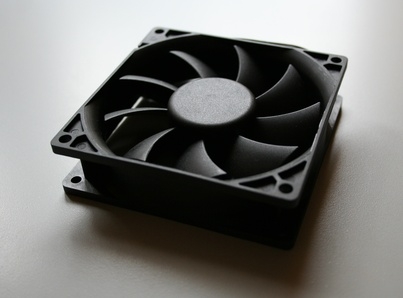
The under-hood cooling fan on a vehicle has the major responsibility of drawing cool air into the engine compartment to reduce the temperature of the radiator coolant. Some vehicles come equipped with a dual fan setup; one cools the radiator and transmission reservoir while the other blows cool air over the engine. Whatever setup you have on your vehicle, testing the cooling fan can be accomplished with a few simple tools and a knowledge of the wiring system.
Put the vehicle in park or neutral with the emergency brake on. While the engine is running, check to see if the cooling fan operates. The small fan propeller should be revolving at high speed when the engine reaches operating temperature. Wait a few minutes to see if the fan comes on (some are equipped with temperature sensors and come on periodically before turning off). You must trace the problem if the fan does not operate.
Separate the wire connector that leads to the cooling fan. Make sure the connectors are clean. Place the test light probe against the positive connector point to check for 12-volt passage; the bulb inside the test light will light up when voltage flows. As an alternate method, use the battery's voltage to jump a hot (positive) lead to the inside of the connector. Ground the other wire. If no current shows using the test light, or the fan does not come on with the battery's power, the problem lies elsewhere.

Remove the top case on the small plastic relay box inside the engine compartment. The relay will be the square-shaped fuse inside the box; most have an aluminum or black coloring. Pull it straight up and out. Replace it with a good used duplicate or with a new one. No fan operation after this step means the relay cannot be the problem. You also can use a small jumper wire to bridge the two connector slots where the relay plugs into the relay box connector. Non-operation of a replacement relay or non-operation with the jump wire means the problem lies elsewhere.

Check both the engine compartment fuse block and the interior panel fuse box. Identify the cooling fan fuse; many of them are larger 30-amp types. Check for blown interior electrode elements in either the glass tube type fuse or the plug-in variety. Blown cooling fan fuses will not allow the passage of current to the motor.

Check the temperature sensor wire that leads to the cooling fan. Apply the test light probe to the connector and wait to see if the test light comes on. If it comes on, and the fuses and relay are operable, and the connector to the cooling fan receives voltage, then the problem lies with the cooling fan motor itself.
Note: Replace the cooling fan motor if all other components test out positive for voltage.
Inspect the fan hub, the small plastic casing in the middle of the fan blade frame (fan hubs appear on older model vehicles). With the engine off, rotate the fan blades manually and detect if it moves with resistance. If it spins freely, the hub has lost hydraulic oil and must be replaced.
Note: Check the fan belt for presence and tightness. On the older model cars, the belt drives the fan off a pulley for power.